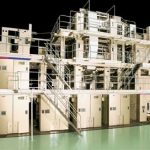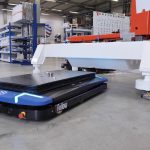Industry Talk
Regular Industry Development Updates, Opinions and Talking Points relating to Manufacturing, the Supply Chain and Logistics.Digitally Transforming Businesses with Robotic Process Automation

Businesses across all industries around the world have had to reconsider their infrastructure, processes and workforces as a result of the pandemic. With additional pressures to meet increased customer demand while restricted by Covid-induced social distancing measures, organisations have had to adapt in order to survive, with many turning to technology to do this. According to recent research, almost half of existing jobs could be automated within the next generation due to technology integration and the acceleration of automation.
RPA – The Key to Productivity
Robotic Process Automation is an IT solution which brings both humans and software together in order to find ways of streamlining mundane processes, in turn, making it easier for humans to complete tasks with more precision. This collaboration helps the human by eliminating as much repetition as possible while also improving speed and efficiency, providing a much better outcome for both the operator and the customer.
This is not a new concept – but the application has evolved over time, from the ability to automate processes to handling business and computing decisions, which has coincided with advancements in other technologies, such as Artificial Intelligence and Machine Learning. The worldwide RPA market is expected to reach nearly $2 billion by the end of 2021, according to Gartner, which is not surprising as the digital solution can help businesses contribute to meeting their strategic objectives and stay competitive, driving future business transformation.
Successful Deployment
As with any new technologies, it’s important to not just simply jump aboard the bandwagon without having any clearly defined processes in place. Automation doesn’t have to remove control or decision making, but instead, enhance processes and empower businesses to make informed decisions in real-time. In order to successfully deploy RPA, firstly, organisations need to consider the business value or pain points that they want to gain or solve from using this technology. Once the business case of implementing automation technologies has been fully evaluated, businesses can then begin to gradually deploy these innovations – rather than overhaul complete operations. The automation solution must fit and work alongside existing processes, while ensuring it is flexible and scalable to meet any changes and growth internally.
Additionally, businesses must ensure that the human workforce is part of the deployment and understands the technology, and the benefits of RPA, minimising the need for them to conduct repetitive tasks and focus their time and attention on more complex needs. When technology can completely eradicate these arduous tasks, individuals will respond well to the change, but people need to be educated, trained and confident in the solution. They need to understand how the technology works and how they work together, as well as the benefits that collaboration will bring.
Big Data
The concept of ‘Big Data’ is driving automation, and particularly Robotic Process Automation, acting as a data-driven process. Vast amounts of data is generated daily, collecting information about performance, accuracy and repeatability, but the value of this information can often be lost if it is left to humans to process. The insights provided by the collaboration between RPA and Big Data can be used to recognise any risks within business processes and help companies resolve and streamline these points within their operations.
A Post-COVID-19 and Brexit World
COVID-19 has acted as a catalyst by accelerating the uptake in automation, especially within the manufacturing and logistics industry. With less staff able to be present within the same environment due to the pandemic, organisations faced significant challenges to meet demand – caused by the boost in e-commerce, increasing by 41% in just three months. But this is where Robotic Process Automation can play a vital role to keep up with the pace of change and to drive efficiency across the business. Such technology is critical to business response and continuity by amplifying automated support systems in order to strengthen a resilient human and machine workforce.
Additionally, Brexit will bring some manufacturing back to the UK, which will continue to accelerate the desire to automate. With even more uncertain times ahead, businesses must prepare for any potential changes, address problems in productivity and constrained budgets – with the implementation of RPA, it can empower digital workers and help to remove repetitive tasks that clog up processes. This is reflected in recent research, which highlighted that business spend on RPA is expected to increase by 20-30% in the coming year as a result of administration overheads related to Brexit. Furthermore, with travel restrictions in place and a change in many mindsets, there may be less travel for business in the future, which in turn, will create an interest in buying and supporting ‘home’ businesses, again, driving the need for automation further.
Conclusion
The UK remains behind globally in the automation and productivity race, but the country is about to play catch up, driven by Covid-19 and Brexit, despite the remaining uncertainty. More and more businesses are inquiring about automation and wanting to find out more about existing technologies to make processes more efficient, such as Robotic Process Automation. By ensuring this technology fits into existing business operations and deploying it successfully, RPA can support the new S curve in the UK for automation, allowing businesses to benefit from improved efficiencies and productivity, in turn, driving business transformation now and into the future.









